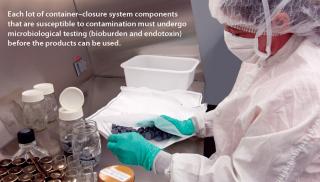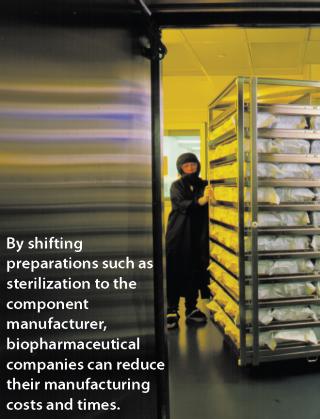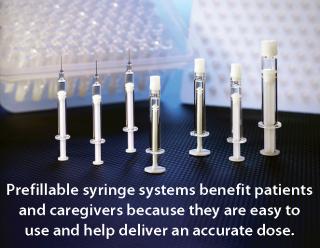Voices of Biotech
Podcast: MilliporeSigma says education vital to creating unbreakable chain for sustainability
MilliporeSigma discusses the importance of people, education, and the benefits of embracing discomfort to bolster sustainability efforts.
October 1, 2010
Containers and administration devices are integral to the safety and efficacy of biopharmaceutical therapies and must be key considerations for all new drugs coming on the market. By partnering with packaging manufacturers early in development, biopharmaceutical manufacturers can increase efficiencies in their production processes while gaining expert advice and counsel throughout a drug’s lifecycle. Such an alignment can also improve product quality, enhance regulatory compliance, and contribute to the overall state of control by preserving biopharmaceutical stability, ensuring sterilization, and customizing delivery systems for market differentiation.

Biopharmaceutical Packaging Concerns
In recent years, an increasing number of biotherapeutics has received regulatory approval. This drives a need for continuous improvement and creates new requirements for primary packaging components. Enhanced regulations and new guidance on current good manufacturing practices (CGMP) are also driving drug and packaging manufacturers to improve production techniques.
Biopharmaceuticals have unique packaging requirements for sophisticated container–closure and drug delivery systems. These products are often more sensitive to interactions with vial and syringe components, which can induce protein aggregation or denaturization. Therefore, qualification and control of materials that contact biotherapeutics are critical to development and manufacturing. For highly sensitive biotech drugs, a packaging solution needs to offer protection from contamination and ensure consistency in every aspect that could affect the fill–finish process or long-term drug stability.
Reducing variation in drug packaging can deliver measurable economic value by minimizing the risk of leachables in the drug solution. Several important concerns about biopharmaceutical packaging should be taken into consideration: diminishing and controlling visible and subvisible particles, ensuring consistency of component extractables, and maintaining consistent dimensions of packaging components throughout production to ensure manufacturing efficiencies and container–closure integrity.
Packaging components come with certified extractable profiles, which provide proof of each component’s chemical consistency at a new level of control. Packaging manufacturers can also identify and control sources of potentially contaminating particles through inspection programs and continuous improvement efforts. All these factors combined can reduce or eliminate the expense and exposure to regulatory risk associated with component preparation, sterilization, and end-of-line rejections. Industry-leading suppliers can help guide drug product manufacturers through such issues and their potential implications.
Regulations and Compliance
Increased compliance requirements and pressure to achieve higher quality has led to a number of new processes that are dramatically affecting processing lines and manufacturing techniques. Development and manufacturing aspects of the pharmaceutical packaging business are shifting. Enhanced regulations and recent CGMP guidance, as well as the overall drug industry trend toward biotherapeutics, have all affected manufacturing while fostering collaborations between biopharmaceutical companies and suppliers of packaging components.
Increased emphasis on quality and a trend toward ultraclean components has encouraged a major shift in the manufacturing of delivery systems, as well. Today, packaging manufacturers are assuming more responsibility for compliance and working alongside pharmaceutical manufacturers to apply CGMP to all aspects of manufacturing. For example, they may implement stricter requirements for their production staff ‘s protective clothing or move testing upstream to minimize variability.
As a result of amendments to US FDA regulations for finished pharmaceuticals (1, 2), component suppliers have joined together with drug product manufacturers to deliver high-quality, sterile drug products. A final rule that took effect 8 December 2008 clarified the need for more stringent compliance concerning the preparation of components for sterile drug products with an overall emphasis placed on in-process bioburden testing (2).
In particular, that clarified the need for each lot of a drug product’s container–closure system components that are susceptible to contamination to undergo microbiological testing (bioburden and endotoxin) before the products are used. Depyrogenation processes used for containers and closures also must be validated. Written procedures for sterilization processes are mandated, including validation for all aseptic and sterilization processes to provide a sufficient level of assurance that drugs are sterile.
Those clarifications require additional validation studies, which in turn creates a burden on equipment and technicians in microbiological laboratories and decreases efficiencies in manufacturing by increasing closure work in process. Much of that is due to additional waiting time for test results. The changes also require manufacturers to revise and create multiple additional documents to ensure compliance.

Sterilization
To answer demands for higher quality, the biopharmaceutical industry has moved toward ready-to-sterilize and ready-to-use closures for its injectable products. This ensures that closures are washed, depyrogenated, and sterilized to reduce the risk for microbiological contamination of drug products. Provided by industry-leading suppliers, these components are prepared using a documented, validated process that complies with international standards and current regulatory requirements.
In today’s manufacturing environment, regulatory guidance encourages pharmaceutical companies to use clean components in filling operations to help ensure high-quality drug products. By shifting advanced preparation techniques such as presterilization to packaging manufacturers, biopharmaceutical companies can reduce manufacturing costs and time investment required to perform such processes in-house.
Packaging manufacturers can help simplify production operations by presterilizing container–closure components in a process that is compliant with regulatory requirements. This step eliminates the need for biopharmaceutical companies to sterilize those products themselves upon receipt, cutting costs and mitigating risks associated with preparing closures and syringe co
mponents.
Successful integration of ready-to-sterilize and ready-to-use components in a drug manufacturing process requires a solid partnership with the packaging manufacturer. Such a relationship can be built with a component supplier during drug development to provide sterile closures that use a validated process to achieve a minimum 3-log bacterial endotoxin reduction. Each lot can then be tested for specific characteristics including endotoxin, bioburden, and particle levels. Receipt of clean, sterile components suitable for filling lines is verified on the suppliers’ certificate of analysis (C of A). Ready-to-sterilize and ready-to-use products, as well as those with certified extractables and particle levels, will serve the industry well as it continues to move toward higher quality and regulatory compliance.
Delivery Systems
Another factor in the success of a biopharmaceutical therapy is the design of its overall drug delivery system. To make the most of a partnership with a component manufacturer, biopharmaceutical companies should seek out those who can provide container–closure systems that are consistent throughout drug development, from research and development through clinical testing to commercialization.
A drug delivery device is an essential element in how a therapeutic will be stored, transported, and administered by its end users. Customized delivery systems such as prefilled syringes and autoinjectors can benefit both patients and caregivers through ease of administration and control of proper dosing. Delivery systems also can be a competitive differentiator — whether among different biopharmaceutical manufacturers or between originator and biosimilar products. For example, autoinjectors are quickly becoming a preferred delivery method for many drugs and biologics used in the treatment of chronic conditions such as rheumatoid arthritis and multiple sclerosis, with which patients often have dexterity issues that affect their ability to deliver a drug treatment with a traditional syringe. As patients become increasingly involved in determining their own best treatment options, biopharmaceutical companies need to consider their ease of delivery and adapt product designs to stay competitive.

Delivery systems can help reduce overfill and improve cost management through use of devices such as vial adaptors. Packaging manufacturers can streamline production processes by identifying potential hazards associated with packaging materials early on and offering custom solutions to reduce the risk of container closure failure.

Successful Partnerships
How can a biopharmaceutical company evaluate a packaging manufacturer as a potential partner? It can begin by investigating several aspects: regulatory compliance, internal controls, washing and depyrogenation, and microbiological testing.
CGMP Compliance: Determine whether a company provides CGMP training for its personnel and whether they follow CGMPs relative to manufacturing, processing, and packaging its components.
Internal Controls: Find out whether a packaging manufacturer has procedures and processes in place for receipt, identification, storage, handling, sampling, testing, and approval or rejection of components. Key considerations should include procedures that evidence validation of the washing, packaging, storage, and distribution processes surrounding component preparation.
Wash Process: Establish whether the packaging company has controls in place to ensure that its water systems do not contaminate drug products throughout component washing. Ask whether the manufacturer uses water-for-injection (WFI) in the processing of its components or in final rinsing.
Depyrogenation: Confirm that the packaging company performs validation of the depyrogenation processes for components that are consistent with industry practice and agency expectations and requirements.
Microbiological Tests: Verify that the packaging manufacturer performs microbiological tests on each lot of components that would be susceptible to contamination.
It is important for a packaging company to address all those critical areas before you embark on a partnership with it. Your ability to understand each other’s processes and troubleshoot potential pitfalls will lead to a sustainable manufacturing process that increases efficiencies while creating components that have fewer issues with contamination and rejection.
As the unique needs of biopharmaceuticals and novel dosage forms drive new systems, collaborations between drug and packaging manufacturers will become more important as a way to produce higher quality products. Biopharmaceutical and packaging manufacturers are collaborating on new ways to continuously improve their products and processes to meet the needs and standards for quality that both drug manufacturers and regulatory agencies are seeking. Such a partnership can enable both companies to increase efficiencies, build sustainability, and improve products and processes throughout the industry. Working together, these manufacturers can exceed expectations and produce new and innovative products and manufacturing processes that will benefit patients worldwide.
About the Author
Author Details
Frances DeGrazio is vice president of marketing and strategic business development at West, 101 Gordon Drive, Lionville, PA 19341; 1-610-594-2900; [email protected]. She has worked in the pharmaceutical packaging industry for over 25 years and has extensive expertise regarding injectable drug product delivery.
1.) 1996.Current Good Manufacturing Practice in Manufacturing, Processing, Packing, or Holding of Drugs: General Code of Federal Regulations, US Food and Drug Administration, Rockville.
2.) 1996.Current Good Manufacturing Practice for Finished Pharmaceuticals Code of Federal Regulations, US Food and Drug Administration, Rockville.
You May Also Like